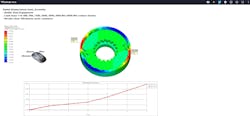Bringing CAE Reporting into the Digital Era
Does today’s product development process match current market demands or is it just a replica of the way we’ve “always done it”? Looking in from the outside, product development can often appear to be a sequential process on a one-way street running from design to production with a side trip for analysis. However, there are multiple touchpoints and feedback loops within and between these stages.
One of the most critical, yet often overlooked and underdeveloped, areas of collaboration is between the CAE analyst and design teams. More than an inconvenience, effects of this gap can ripple throughout the organization, causing delays, excessive costs and bad decisions.
Analysis
Beginning in the early pre-manufacturing stages of product development, designs are handed off to analysis to validate if the proposed product design will perform as intended in the real world.
During these studies analysts employ digital computer-aided engineering (CAE) tools utilizing advanced computational methods to evaluate and optimize the performance of designs relative to loads, temperatures, conditions and environments in which they will operate. CAE analysts then present the results of their work to confirm the product’s structural integrity and guide design decisions.
PowerPoint…Seriously?
While the tools to design, analyze and manufacture products have advanced exponentially over the years, the same cannot be said for the post-processing and reporting of simulation results. For many organizations, PowerPoint slides continue to be the default method for capturing, reporting and sharing CAE results.
This manually intensive process not only lacks detail but adds needless time and cost to the product development process, as CAE experts often spend days with the non-value-added task of cutting and pasting results images onto static slides for presentation.
Fortunately, a new class of tool has emerged to bring digital transformation into the CAE results review process. Now designers, CAE managers, analysts, release engineers and others can interactively view, interpret, interrogate and share simulation results in a fully 3D digital environment. The result is immediate reporting that leads to timely and accurate decision-making.
Prasad Mandava, co-founder and CEO of Visual Collaboration Technologies, Inc. (VCollab), explained that such benefits allow designers, CAE managers, analysts, release engineers and other stakeholders to interactively access the most accurate and complete information to make key product design decisions.
“Non-interactive static 2D documents such as PowerPoint slides, images or videos are decades-old and simply not designed to operate in today’s 3D digital environment,” said Mandava. “These platforms limit the opportunity to fully realize the benefits of CAE simulations and maximize investments in related resources and technologies. The consequences are extensive administrative work by high-value CAE analysts, and a lack of insight to guide designers and critical decision-making.”
Case Study: Amsted Automotive
Headquartered in Southfield, Mich., Amsted Automotive produces over 100 million components and assemblies annually. The company’s products range from piston pins to advanced metal forming and complex assemblies for vehicle drivetrains; powder metallurgy drivetrain components and soft magnetic composites; torque management solutions for electric drivelines and propulsion systems; and large-diameter cold-formed products.
The company’s senior CAE manager, George Coppens, explained that the steps PowerPoint reporting approach was extremely time-consuming and counterproductive.
“Once critical areas of interest within the product were determined, analysts were forced to capture and paste screen images of the results into PowerPoint slides, obtain values in the post-processor, create labels in PowerPoint and repeat the process for hundreds of slides,” Coppens said.
“To add to the problem, after the report was presented, our analysts would often receive requests to go back and clarify areas of interest by adding additional images,” he continued. “This not only pulled analysts away from other projects, but it created a significant delay in getting analysis findings back in the hands of designers and other stakeholders.”
A Better Way
Amsted Automotive set out to improve the process for sharing CAE insights. Objectives included improvements to time, cost and the ability to interrogate reports more thoroughly. Among other areas where the company sought to make gains:
- Better utilization of CAE resources.
- Increasing the capacity and availability of analysts for additional simulation studies.
- Reducing the time to create reports, as well as their length, and improving consistency in structure and content.
- Eliminating the prospect of human error through automation and never missing identifying a high-stress area.
Increasing the detail and value of the information contained in the reports would not only allow for better, faster design decisions, but the need for follow-up requests for additional detail would be practically eliminated.
CAE Viewer and Collaboration Software
In 2021, Amsted Automotive discovered VCollab which would soon revolutionize the way CAE reports were shared. The software leverages the CAE model itself, allowing design teams to explore simulation results while making comparisons and annotations. A quick survey of the market confirmed that VCollab was the only solution that could create reports with interactive content.
With VCollab, Amsted Automotive discovered that:
- Analysts can create, update and share results in minutes.
- CAE managers, analysts, designers, release engineers and other stakeholders can collaborate freely and in real-time, allowing them to interactively review key 3D simulation results and failures.
- Non-value-added manual tasks, bottlenecks, and delays are reduced or eliminated.
Implementation
Embracing change can be challenging. To help with the transition, product engineers were introduced to VCollab during the evaluation stage. Engaging this group early in the process helped to answer questions and solidify their buy-in.
“Our initial goal was to provide users with a template for automating many of the manual steps in creating reports,” Coppens said. “The implementation began by leveraging VCollab’s off-the-shelf intelligent automation and developing Python-based automation templates. Shortly after, our analytical engineers began using VCollab to generate reports as needed. Today, the entire engineering analysis team uses VCollab.”
Coppens reports that the collaboration software is meeting or exceeding expectations as the company has registered a significant reduction in the time and effort needed to create CAE reports. Before the implementation, days were required to report the results of a CAE study; interpretation of these results can now begin in hours.
In the months ahead, the company plans to leverage VCollab technology even further with an increased use of Python scripts to build a library of automation templates that add information to reports and leverage the software’s automatic hotspot finding feature.
Armed with this feedback, Amsted Automotive’s design and engineering teams can continue to be responsive to the lofty expectations of its growing customer base.
Rapid Results Review
In addition to automated digital report generation, Amsted Automotive is further boosting CAE process efficiencies by incorporating VCollab’s “Rapid Results Review.”
This capability is touted for its ability to “quickly extract and visualize analysis results from a broad range of multi-physics solvers, skipping the time-consuming manual post-processing process as we know it today, and help companies make faster and more informed design decisions.”
Rapid Results Review allows engineers to go directly from analysis to design decision through:
- Smart automation and efficient multi-format graphic displays (Digital Slides) to be used for design review meetings.
- Allowing ease of sharing graphical results data with the engineering teams.
Digital Collaboration
With nearly 80% of a product’s total cost committed at the upstream design stage, today’s accelerated product development processes place a greater emphasis on simulation. The results from CAE analysis guide critical product design decisions. With static, 2D reporting, simulation insights need many iterations before they can be shared throughout the extended enterprise or with OEMs and suppliers. The consequences are extensive administrative work by costly CAE analysts and a lack of insight to guide critical decision-making.
Today’s new class of tools for post-processing, reporting and sharing simulation results are removing the CAE reporting bottleneck and allowing companies to fully maximize their CAD/CAM/CAE investments.
William Carrelli is a 40-year veteran of the CAE and PLM markets, where he has led strategy and marketing activities for SDRC, UGS and Siemens. He currently serves as a marketing consultant to engineering technology companies.
About the Author
William Carrelli
William Carrelli is a 40-year veteran of the CAE and PLM markets, where he has led strategy and marketing activities for SDRC, UGS and Siemens. He currently serves as a marketing consultant to engineering technology companies.


